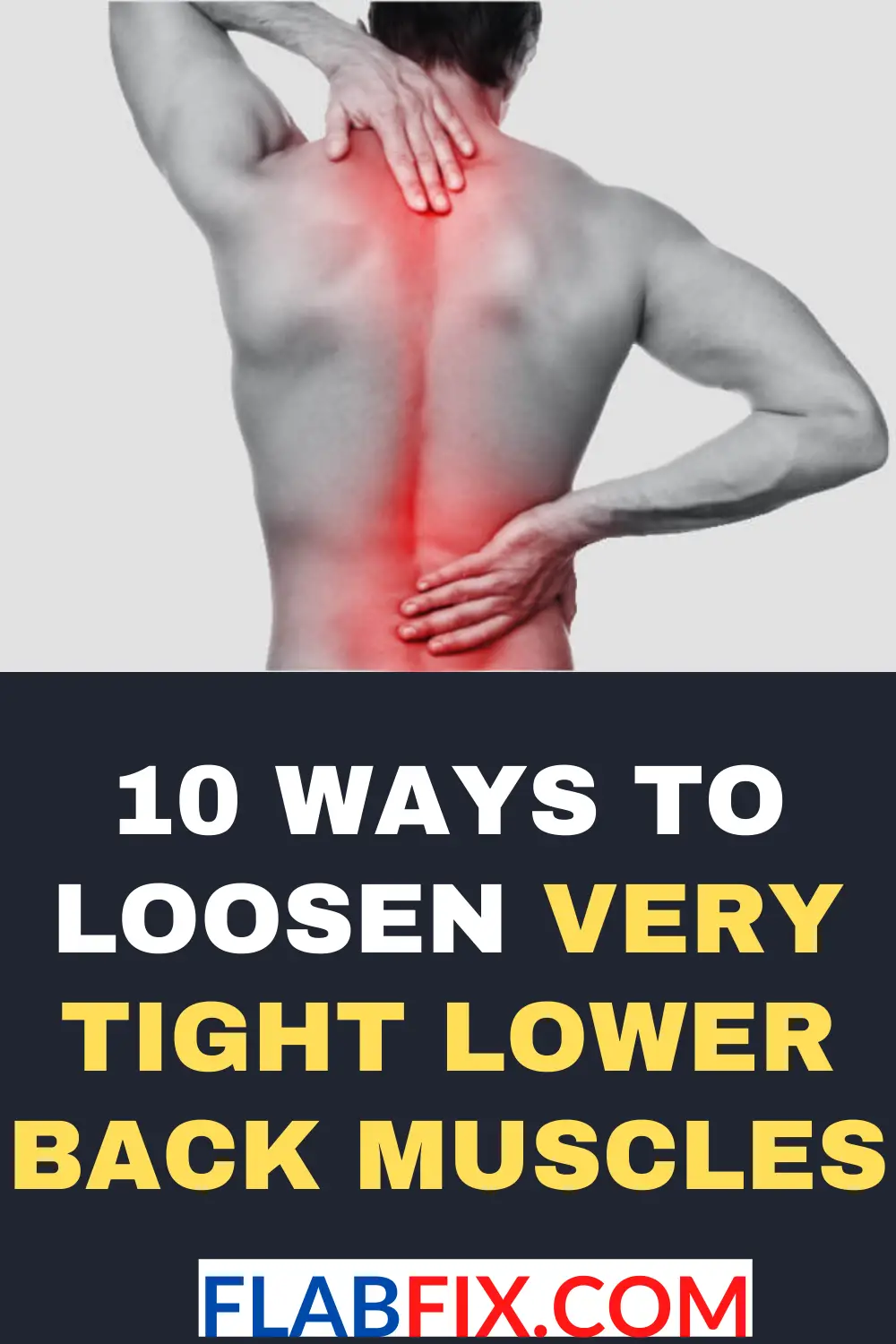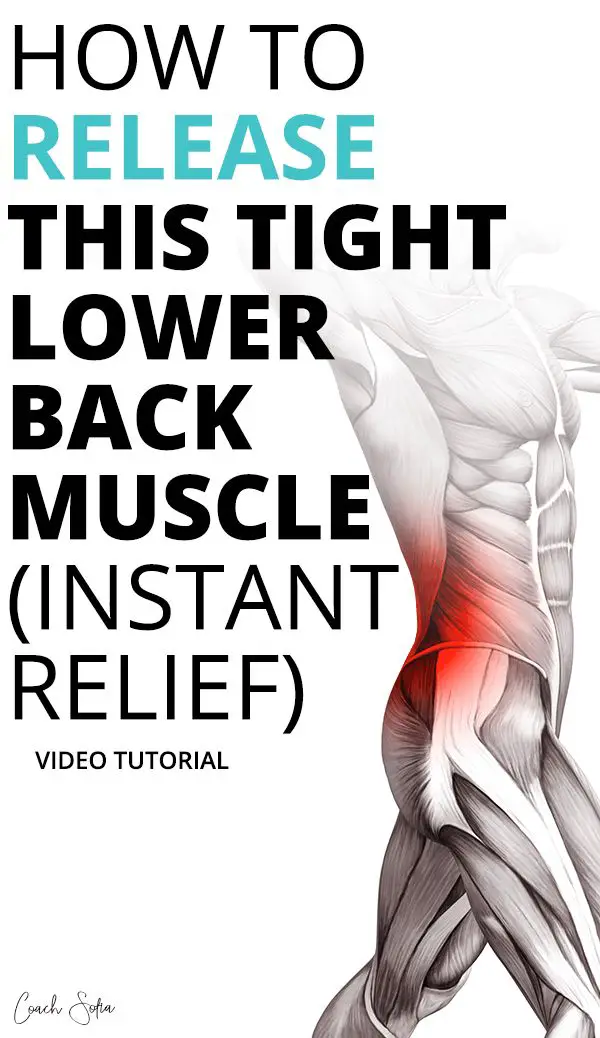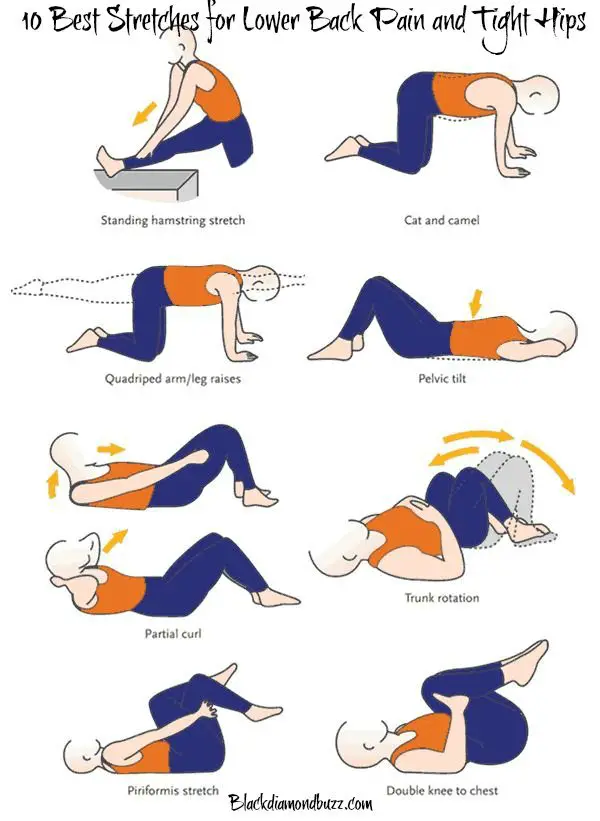Stretching: 4 Stretches To Support Muscle Recovery And Prevent Injury
The key is to focus on full body mobility, strength and flexibility to stop your back from hurting. But, in saying that, theres nothing quite like releasing the tension out of a sore back with a good stretch. Chatty says that you should do a mixture of dynamic stretches those with a little movement or pulses and static, or still, holds.
Dynamic movement increases the mobility of the muscle group being focused on, and also increases blood flow to that area, she explains. Static stretches get into the fascia in the joints, bringing increased blood and synovial fluid to tight areas. But static stretches pre-exercise can bring a looseness to the body that will not support you through a workout.
Here are 4 her favourite stretches for the lower back to help relieve pain.
Stretch #4 Hamstring Stretch
The hamstring stretch is a great exercise to do at home. The reason the hamstrings need to be stretched when lower back pain is present is that the hamstring attaches to the pelvis. If these muscles are tight of experiencing tone they can affect the position of the pelvis which can be related to low back pain. If the pelvis is tilted by the hamstrings over time that position may produce symptoms further up the spine.
These areas are related through a system called the posterior chain. The posterior chain is all of the muscle from the back of the ankle to the back of the head of the posterior, or back side of the body.
This system works together to regulate anterior, or forward movements of the body. If these muscles are tight or weak that can be a source of issues for the spine.
Stretching the hamstrings can be done several ways, but laying on your back with both knees bent and feet flat is a great starting point.
Once in that position, lift one leg straight up in the air leaving a slight bend in the stretching legâs knee and move that leg closer to your body. There will be a sensation of stretch in the hamstrings between the bottom of the glute and back of the knee. You can use a towel of some sorts if you find that useful.
Improve Posture And Work Ergonomics
The natural curve of your spine is reinforced by correct posture to help you breathe and function properly. Having a poor posture, slouching, crossing legs, cell phone use, and incorrect ergonomic practices can lead to tight muscles, discomfort, pain, and health problems.
To improve your posture, it is important to be intentional and mindful with your activities. If you tend to look at your phone or read books with a slouching posture, move your hand up slightly, and move it up to the eye level while relaxing your shoulders and moving your head back to the right place .
Posture-correcting exercises can be an effective way to learn a good posture. You can find some of my favorite exercises, such as the hummingbird to correct posture and reduce tight muscles here. The hummingbird is a fantastic way to strengthen the muscles between your shoulder blades to improve posture and to reduce tight muscles:
- Lifts your arms so they are parallel to the floor.
- Bend your elbows and face your palms forward to form a 90-degree angle between your biceps and forearms.
- Rotate your arms backward in a circular motion while squeezing your shoulder blades together.
- Repeat this exercise for one minute.
Read Also: Can Being Constipated Cause Back Pain
Stretch #3 Lumbar Rotation
This is the first stretch in the series that is progressive assuming the previous movements were tolerable.
Laying on your back with your knees bent and feet flat, put your knees and feet together as if you had a mermaid tail. Next, take a deep breath in a and as you exhale slowly drop your knees to the side, inhale bringing the legs back up to the starting position and exhale again as you drop them to the other side.
You do not need to have your knees touch the floor, work within your own pain-free range of motion.
Working this movement side to side creates a rotational motion in the lumbar spine and can help reduce tension if you are trying to fix lower back pain at home. This is a great exercise because it is an unassisted stretch that targets the low back which can be a difficult area to alleviate pain on your own.
Move : Seated Lower Back Rotational Stretch

Image Credit:
Tip
“As you rotate, if you feel a point that you get stuck, take a few deep breaths and on the exhale, try to rotate even further,” Becourtney says.
Don’t Miss: What To Do If You Pull Your Lower Back
Sauna Bath And Steam Room
A hot bath or going to a steam room or a sauna to relax. These options operate by increasing the bodys temperature, which in turn increases your blood circulation.
With increased blood flow, all muscles in your body can receive more nutrients and more oxygen. Spending just 10 minutes in the water, steam room, or sauna will make the muscle wonders work. If you have an injury, make sure to add some ice after a workout before taking a hot bath. Its much easier to do some stretching exercises while in the water.
Causes And Diagnosis Of A Pulled Back Muscle
Trauma, stress, and tension may all cause strains and sprains. Some of the most common causes include:
- Falling, especially if you hit the ground hard or fall in an awkward position.
- Repetitive movements that stress and irritate the back muscles.
- Unsafe lifting, lifting while twisting, or lifting a very heavy object. Parents sometimes injure their backs throwing or playing with children.
- Excess weight that puts excess strain on back muscles. People who are overweight, people who suddenly gain weight, and pregnant women are more vulnerable to pulled muscles.
- A sedentary lifestyle. This may weaken the back, increasing the risk of injuries.
- Poor posture when sitting or bad form when doing athletic activities.
A medical professional may suspect a strain or sprain based on symptoms and your medical history. If another injury, such as a broken bone or herniated disc, is possible, the provider may do other tests, such as an x-ray or MRI scan.3
Also Check: What Could Cause Middle Back Pain
Lumbar Stretches: Are You Ready To Stretch
Now that you know about these lumbar stretches, its time to test them out. Before you know it, youll be experiencing less pain in your lower back. If you think you may need professional treatment or your lower back pain, make sure to get in touch with us today. Additionally, if youre experiencing neck pain, make sure to check out this guide to discover the causes and treatments of moderate to severe neck pain.
Last Post
Stretches To Ease Lower Back Pain
My back is killing me. These five words are said by co-workers, family, friends, almost every person we regularly come in contact with will say them sooner or later. In fact, a study performed at the University of North Carolina found that more than an overwhelming 80 percent of people will experience an episode of back pain at some point in their life. As people age, often the spine will experience degenerative changes. As these changes occur, there is less space between the vertebrae, which can increase back pain. When the spine is flexed, pressure is off-loaded. Because of this, a flexion based program is often used to help relieve symptoms of lower back pain. Here are four stretches for lower back pain that almost everyone can do.
Recommended Reading: Is Walking Good For Lower Back Pain
Tight Quads Pull The Pelvis Down
The quadriceps are front-of-thigh muscles. One of the four muscles that comprise this groupthe rectus femorisattaches to the pelvis at a place called the anterior superior iliac spine . This means the rectus femoris is the only one in the quadriceps group that crosses over your hip joint .
Keep things simple by thinking of your ASIS as the front part of your hip bone. For your reference, the ASIS is a place you can actually touch.
When the quads get really tight, they pull on the hip bone, which in turn tips the whole pelvis downward, or forward, into a position technically called anterior tilt of the pelvis.
Because the spine wedges in between the two halves of the pelvis, if the pelvis is brought into an abnormal forward tilt by your tight quads, the lumbar spine can adopt more curvature than it is supposed to have.
This tends to increase the arch in your lower back. An increased lower back arch, technically called excessive lordosis, is often accompanied by very tight back muscles. Tight quadriceps muscle also may result in weak or overstretched hamstring muscles.
Stretch #5 Hip Flexor Stretch
Building off of the concept of posterior chain it is important to consider the anterior chain as well.
Deficits in strength and flexibility can lead to several issues and lower back pain is most commonly coupled with weak and tight hip flexors. The hip flexors are the iliacus and psoas muscles. They are primarily responsible for lifting the femur into flexion .
When the pelvis is tilted forward through sitting, poor exercise technique, etc. there is a higher likelihood that the hip flexors will be in a shortened position as they attach to the lower spine and inside of the pelvis.
Over time this can cause weakness and tightness and encourage lower back pain. Fixing this issue at home takes time, but can be done through a hip flexor stretch.
Kneeling on the ground with the front foot put far out in front of you lunge forward while keeping your trunk over your hips and head up. The stretch will occur in the front of the thigh and hip toward the medial part of the leg that you are kneeling on. Hold this stretch for 30 seconds breathing in and out then switch to the other leg.
Read Also: What Are Some Good Stretches For Lower Back Pain
Tight Muscles: 10 Steps To Relax And Reduce Pain
Everyone experiences tight muscles throughout their lives. Tight muscles can occur for a number of reasons. They can be temporary or chronic, either way, they can be frustrating and painful. They can limit your movement and interfere with your life in a number of ways.
The good news is that once you understand the underlying reasons behind your tight muscles, you can improve them naturally. Im excited to share some simple techniques that can help you relax your muscles and regain your health. Learning more about the reasons behind tight muscles and understanding 10 simple steps to relax and reduce your pain may help you eliminate tight muscles and pain.
Condition Your Inner Hips

Your inner thigh or groin muscles, also known as adductors, play a role in pelvic positioning, and therefore the sideways tilt described above.
Adductor action opposes that of the outer hips, so when the outer hip muscles contract or get tight, the adductors may become stretched, or vice versa. When they are working properly, adductors help you balance when you’re standing. They also bring the thigh across the midline of your body. But when they get tight, they may alter your pelvic position and overstretch the abductors, leading to a sideways pelvic tilt that affects the spine that is similar to the one described for the outer hip muscle imbalance in “Condition Your Outer Hips” above.
Many people have weak adductors, even though they are tight. In this case, add some inner thigh strengthening to your mix, but don’t forget to stretch, as well.
Recommended Reading: What Is Lower Back Pain Caused From
Stability Ball Reverse Leg Raise
Lie facedown on a stability ball with your hips on the ball, hands on the floor with shoulders over wrists, and legs extended out straight, toes resting on floor. Keeping legs as straight as possible, engage your glutes and your lower back to lift legs until they are in line with your torso. Lower back down to the starting position. Repeat for 15 reps.
Treating A Pulled Back Muscle In 8 Steps
No matter where a pulled muscle is in the body, the steps to treat it are generally the same. However, its important to talk to a medical professional before treating an injury because symptoms of other injuries, such as disc problems or a broken bone, may resemble strains and sprains. After talking to a professional, try the following steps:3
Apply cold. Cold helps reduce inflammation, which is the primary source of pain in the first few days. The faster you can apply cold to a pulled back muscle, the faster you may reduce pain, help control swelling, and start the healing process. Apply a cold pack for 15-20 minutes as soon as the injury occurs. Take a break of at least 20 minutes between each cold application.
Use compression. Applying compression bandages or using an active compression system may help reduce swelling and edema so the damaged tissues can repair themselves more quickly.
Rest. Right after a muscle strain, it is important to limit your activity level and avoid movements that increase pain. After the initial pain subsides, returning to previous level of activity may help prevent the muscles from growing weak.
Stretch. According to Kojo Hamilton, MD, as you return to activity, gentle stretching exercises may improve tissue healing by bringing more blood flow to the injured area. Applying heat to the area prior to stretching may also be beneficial. Ask a doctor about the right stretches for your condition.
Also Check: What Causes Pain In Left Hip And Lower Back
Back And Butt Fitness Tips For Your Backache
Most people who have tight low back muscles or pain in their low back that’s due to muscle spasm, misalignment, or posture problems spend a lot of time doing back stretches. What they don’t know is that both tension and weakness in the muscles that surround the hips and buttocks likely play a big role in their pain.
Move : Knee To Chest Stretch
Image Credit:
Tip
Try to keep the small of your back glued to the ground as you perform this static back stretch, Becourtney says.
Read Also: How To Relieve Bulging Disc Pain In Back
The Truth About Back Pain
When it comes to lower back discomfort, it’s often not the lower back at all that’s causing the problem. Lots of different muscle groups are connected to the lower back, and when one of those muscles is tight it can pull on the lower back and cause pain.
For example, tight hamstrings are a common cause of low back pain. Sitting all day can cause the hip flexor muscles on the front of your pelvis to become shortened, which can also lead to lower back pain. This is why simply doing lower back stretches, although they may provide temporary relief, isn’t the best way to treat your lower back pain and tightness.
Increase Your Magnesium Intake
Magnesium induces muscle relaxation. You will find a lot of magnesium-rich fruits and vegetables.
Bananas are a great magnesium source, such as peanuts, spinach, almonds, and brown rice. Alternatively, you should take magnesium supplements to increase your magnesium intake, helping relax tight muscles.
Before taking any supplement, make sure to speak to your doctor.
Also Check: How To Sleep To Relieve Upper Back Pain
Tips For Managing Back Pain
Some simple steps can help relieve pain and reduce or prevent reoccurrence:
- Stay mobile. Movement can help relieve stiffness. Try to keep active and do some gentle stretching and exercise throughout the day.
- Medication. Over-the-counter pain medication, such as ibuprofen or acetaminophen, can help temporarily relieve pain and reduce inflammation.
- Complementary therapies. Some people find that massage, acupuncture, or transcutaneous electrical nerve stimulations helps with longer-term back pain.
- Posture. Practice good posture while sitting. Try not to slouch, take regular breaks, and ensure that chairs and workstations are suitable and set up correctly. Some people find that standing desks help.
- Yoga and Pilates. Many people find that activities such as yoga and Pilates can help improve posture and relieve back pain.
Stretch #1 Knees To Chest

More than anything this stretch it to make sure you are in a position to move forward to more complex and intense movements. But it also allows an opportunity to get simple range of motion in the legs and pelvis to stretch the surrounding musculature.
Doing this exercise to fix lower back pain at home you will want to start with finding a comfortable place to lay down on your back.
Slowly bring your knees to your chest and grab the front of your knees with your hands pulling your legs closer to your body as able. You should feel a sensation in the glutes and hamstring as well as the lower back where you are experiencing pain.
Hold this stretch for 30 seconds, take a break, and then repeat to give your low back relief.
Don’t Miss: What To Take For Arthritis Pain In Back